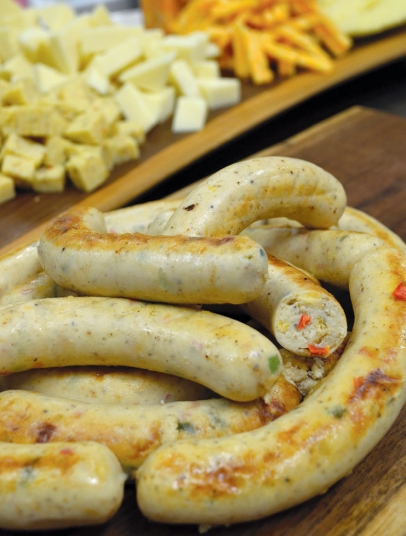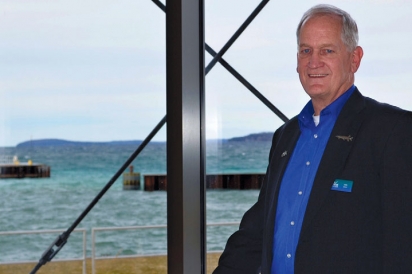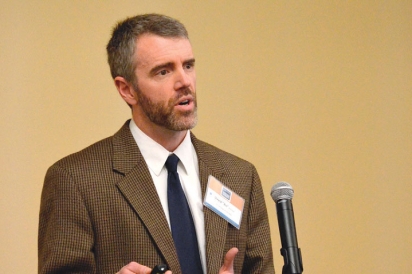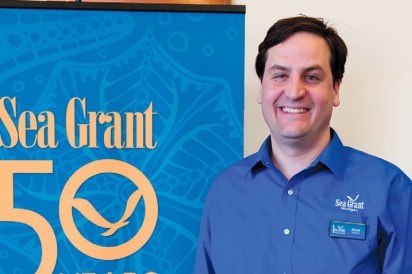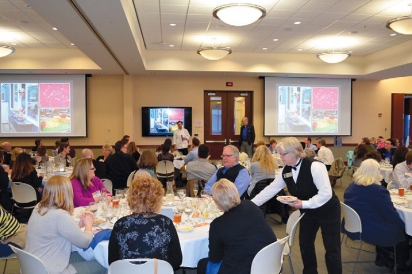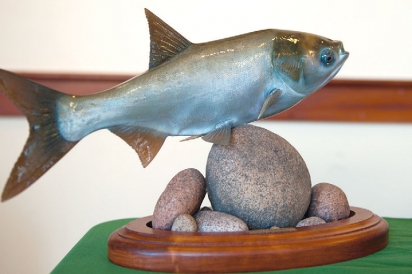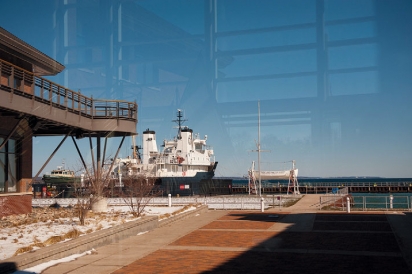Let's Talk About Fish
Food for the mind, body and soul at the 2016 Michigan Seafood Summit
Summer is here, and we’re back outdoors, enjoying backyard barbecues and picnics at the beach or the park again. Lucky for us, in Northern Michigan the menu choices available for those kinds of gatherings go beyond the usual hamburgers, ribs and brats, because we have other intriguing options: whitefish, walleye, rainbow trout, salmon, lake trout…
That said, there are still many for whom the bounty of our local lakes, rivers and streams remains somewhat exotic. How much do you really know about—and care about—Michigan’s freshwater fish species and the bodies of water that they call home?
If you were in attendance at the 2016 Michigan Seafood Summit at Traverse City’s Hagerty Conference Center on April 8, you were no doubt enlightened and inspired to know more and care more—on a culinary level as well as an intellectual level. The Hagerty Center was an appropriate choice of venue, since it overlooks West Grand Traverse Bay and also houses the Great Lakes Culinary Institute, the Great Lakes Water Studies Institute and the Great Lakes Maritime Academy.
On that bright early spring day, commercial fisheries professionals, aquaculture specialists, people involved in processing and marketing, chefs and restaurant owners, local sport fishers, students and the general public came together for a day to discuss—and taste—the future of seafood in Michigan.
“Why seafood?” you might ask. One reason lies in the name of the Summit’s sponsoring organization, Michigan Sea Grant, which is part of the National Sea Grant College Program—a network of 33 universities in coastal states (as the “Third Coast,” that includes us) across the country. The college program is administered through the National Oceanic and Atmospheric Administration (NOAA).
“We spent some time discussing the name for the Summit in our original planning,” says Jim Diana, director of Michigan Sea Grant. “But since there are shrimp and barramundi produced in Michigan—both are marine in origin, and shrimp are not fish—we thought seafood was more accurate in the title than freshwater fish, to cover the full range of products involved.”
ON A MISSION
Michigan Sea Grant’s one-line mission statement is “Dedicated to the sustainable use of Great Lakes resources.” Diana’s own statement takes a broader approach: “I like to say that we provide research, education and outreach focusing on the sustainable use and conservation of the Great Lakes ecosystem.” And while neither of those statements mentions the word “fish” (or “seafood”), it was at the heart of everything the most recent Michigan Seafood Summit wanted to communicate.
The agenda for the event was divided into morning and afternoon sessions, aimed at professionals and the general public, respectively. The morning session covered such topics as local sales through farmers’ markets, commercial fishing, aquaculture permitting and technology advancements, and tourism aspects (including a presentation on Leland’s Fishtown and the Pure Michigan ad campaign about sport fishing). The afternoon was devoted to discussions and presentations on net-pen aquaculture, developments in trout culture, and the ecology and fisheries of the Great Lakes. A highlight of the day was a tribute to the legacy of Tom Kelly (1948–2016), who founded the Suttons Bay–based Inland Seas Education Association (SchoolShip.org) and was the first Michigan Sea Grant educator.
“The primary purpose of holding the Summit is to draw attention to fish as a fantastic food source—a food source that is grown or caught close to home—right here in Michigan,” says Mark Breederland of the Michigan Sea Grant Extension in Northwest Michigan (part of the Grand Traverse MSU Extension). There is a strong whitefish trap-net fishery in our area as well as the largest aquaculture operations in the state within 50 miles,” adds Breederland. “And with the tremendous success of local ‘farm to table,’ we need to expand that idea to include local ‘waters to table.’”
Whether it’s wild-caught or trap-netted or aquaculture-farmed, fish is a heart-healthy food choice, providing an excellent source of protein and healthy omega-3 fatty acids. Farmed rainbow trout and wild lake whitefish from Michigan are also listed on Monterey Bay’s Seafood Watch as a “Best Choice” for ecologically responsible production and harvest practices. “Harvesting local whitefish is about the lowest energy footprint you can get,” says Breederland.
TASTING IS BELIEVING
Diana emphasizes that one of the most important things he hopes people took away from this year’s Summit was “that Michigan commercial fishing and aquaculture businesses produce sustainable, high-quality seafood that can be prepared in many ways to provide diversity to our diets.”
The sumptuous evening banquet that capped off the event certainly did its part to underscore that message. Prepared by Hagerty Center Executive Chef Scott Williams, GLCI Garde Manger Chef-Instructor Bob Rodriguez and GLCI Chef-Director Fred Laughlin, along with staff and students, the seven-course menu (see sidebar) featured variations on whitefish, lake trout, rainbow trout and yellow perch. Williams, who created the menu, says his goal was to showcase different cooking techniques and presentations for each course. “I also tried to keep it as local and seasonal as possible with the other ingredients and pairings—as much as you can do at the beginning of April in Northern Michigan!”
Rodriguez, who was in charge of the items for the charcuterie board, says he really enjoyed making the lake trout sausage in particular. “I don’t get to do that very often” he says. “Fish sausage sounds a bit strange to people who have never had it, but it’s great if you make it right. Lake trout has a good amount of fat in it, so it’s not going to dry out. We did a basic mousseline, which gets its fat from eggs and cream, and added some chives, roasted red pepper, and toasted coriander and fennel seeds. With freshwater fish, you have to season it well with salt, but also to be careful not to over-season it. And, since there are obviously no fish casings, we used hog casings. I don’t like the artificial, collagen-style casings, especially with something as delicate as fish—they are kind of tough.”
For the smoked rainbow trout, he used an Asian-style pineapple-sesame cure, garnishing the finished product with an array of pickled vegetables. “One was an asparagus pickle, and I did a sweet pickle for the carrots and a mustard-turmeric pickle for the cauliflower. They were beautiful—so colorful—and they complemented the smoked fish very well.”
Rodriguez also supplied the smoked whitefish for Williams’ pâté, using a regular cure of salt, sugar and black pepper. Williams added the beet salad course as a palate cleanser, followed by his take on fish & chips, using perch and substituting the usual club soda in the tempura batter with local beer. The final two courses were cedarplanked whitefish and potato-crusted rainbow trout (see recipes).
Laughlin, who teaches baking in addition to his duties as GLCI director, supplied fresh breads (made with Grand Traverse Culinary Flours) and dessert for the banquet, which was an all-around hit with guests and organizers alike. “It was a truly fabulous meal of local food fishes,” says Breederland.
Although Michigan seafood is not difficult to cook, there are certain guidelines to follow to ensure the best result. Williams notes for that whitefish, trout and walleye, for example, all have a prominent line of pin bones that need to be removed, either with pliers or fish tweezers, or by cutting out the whole line with some flesh. Also, because these types of fish are so fine textured and low in fat, Williams recommends cooking them whole—or in the case of fillets, leaving the skin on. “The skin adds flavor and keeps the fish from drying out, and after roasting or grilling, it can easily be removed,” he says. “Finally, you have to take seasonings and sauces into consideration. They shouldn’t be too heavy or they will overpower the taste of the fish.”
Williams and Rodriguez say they enjoy eating and cooking with all kinds of freshwater fish, but both list their favorite as steelhead salmon, for its richer flavor and the number of ways it can be prepared. “I do something different every time with salmon,” says Rodriguez. “When I make gravlax, I like to finish it by painting it with a pastrami-style coating, which has molasses, coriander, black pepper and a little bit of paprika in it. Serve that with some crème fraîche, sliced onions and capers, and you have something really good. But salmon is also great simply pan-fried or done on the grill.”
If your appetite for Michigan seafood—or lake fish, call it what you will—has been whetted by all of this, your appreciation of the magnificent bodies of water all around us in this state us has hopefully been heightened as well. They give us so much in terms of beauty, recreation and—yes—delicious and nutritious food sources, that we should all be on board to give back in whatever way we can. As a Michigan Sea Grant brochure points out, Michigan is at the heart of the largest surface freshwater system on earth. With over 3,000 miles of Great Lakes shoreline, 11,000 inland lakes and 36,000 miles of rivers, Michigan has about onefifth of the world’s fresh surface water supply and nine-tenths of the U.S. supply. This makes stewardship of our water resources not only important for us locally, but for the whole Great Lakes region and the world.
Janice Binkert, a graduate of the Great Lakes Culinary Institute, is a food writer, personal chef and caterer based in Traverse City. Contact her at jbinkert6@gmail.com.
MICHIGAN SEA GRANT
Michigan Sea Grant, founded in 1969, is a cooperative program of the University of Michigan and Michigan State University that helps to foster economic growth and protect Michigan’s coastal Great Lakes resources through research, education and outreach. The U of M School of Natural Resources and Environment and the MSU Extension Greening Institute provide matching funds to carry out programs in Michigan.
What are some of the key things Michigan Sea Grant does?
• Promotes a better understanding, conservation and use of Michigan’s coastal resources by working with a broad range of Great Lakes stakeholders in both the private and public sectors
• Supports coastal communities and businesses through the statewide Sea Grant Extension educators
• Develops Great Lakes educational materials, operates an online bookstore and sponsors hands-on K–12 cruises and camps
• Funds Great Lakes research projects designed to provide science-based information about the use and conservation of Great Lakes resources
• Provides undergraduate and graduate student fellowship opportunities for a chance to apply academic training in ecology, natural resources, policy or law to real-world issues
For more information or to browse the online bookstore, visit MISeaGrant.UMich.edu.


